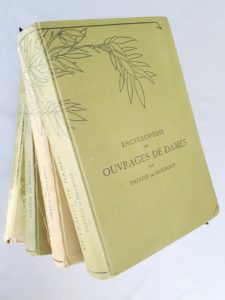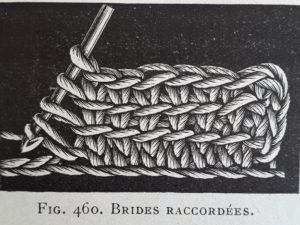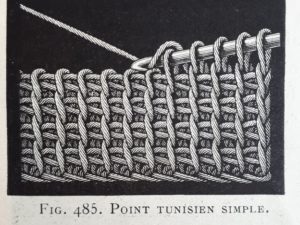I have several copies of the Encyclopedia of needlework by Thérèse de Dillmont. All in French. But I know this book exists in many other languages.

It is not a new encyclopedia. Thérèse de Dillmont lived in the 19th century and her encyclopedia was first edited in 1886. I have not found any publication date in the books I have, but I think they were printed after 1886. In one of the books, the editor’s foreword mentions the Universal expo in Chicago, so it would be in 1893 or 1933. Difficult to say. To note: The books I have are not all identical. Two copies are “reviewed and updated”, two copies do not have colorful illustrations (only black and white drawings).
The encyclopedia is a wide collection of different techniques and the chapter I read with utmost attention is the one about crochet.
Two kinds of crochet
In her encyclopedia, Thérèse de Dillmont makes a distinction between 2 types of crochet:
- the “crochet allemand” (my translation: German crochet), i.e. the traditional, standard crochet with chains, single crochet, double crochet…. Why German? Thérèse de Dillmont does not say.
- the “crochet Victoria” or “crochet tunisien” or “crochet-tricot“. Thérèse de Dillmont only mentions the 3 names to refer to the same technique but not a single word about the origin of it. Further on, she essentially uses the name “Tunisian crochet”.
I’m really curious to see how this part of the book was translated in other languages. So, if you happen to have a copy in another language than French, let me know!
Crochet terminology in French
Crochet terminology in French has not changed much over time (a time span of over 130 years, not bad!). I’ll spare you the details on the few names I report to the attention of French-speaking readers.
Linked double crochet (US) and Tunisian crochet
Thérèse de Dillmont describes several types of double crochet stitches (US terminology), one being the linked double crochet. The description of this stitch in the book is confusing. But the picture next to it is amazing and helps much better than words:

Let’s compare with the picture showing Tunisian simple stitch.

When you rotate one of the two pictures, it becomes obvious that linked double crochet stitches are in fact very short rows of Tunisian simple stitches.

As an FYI, if you look at the bottom of the page opposite the title page, there should be a small 3 or 4 digit number at the bottom of the page. That number represents the month and year that book was printed. This number corelates with the text near the top of the same page that lists how many copies have been issued of the book to date.
The “New Revised and Expanded Edition” came out sometime after ~1901 and before 1909. All versions of this edition have the date code listed where I described above up until 1971, when the book was finally, for the first time, published with a copyright date on it. This means the books you have that do not say “New Revised and Expanded Edition” date from sometime between 1886 and 1909. (Or date to the 1970s when they stopped listing how many copies issued.)
The oldest date code I’ve found so far is 410 – April 1910 (620,000 copies issued). The oldest date code I’ve found is 755 – July 1955 (1,590,000 copies issued). I’ve found one issued sometime after 1959 (based on handwritten inscription in the book) showing 1,625,000 copies issued but unfortunately, the page was torn at the bottom so I don’t know the date code on it.
To the best of my knowledge, The Encyclopedia of Needlework has been printed in at least 17 languages.
I hope this helps!
Thank you for these details. I had a close look at the bottom of the page opposite the title page but it’s completely blank. In all the copies I have. Could it be that, depending on the language, references about publications may be different? I see a price list for the book in different languages (and currencies). All my copies are in French. A book published so many times over such a long period of time in so many different languages, for sure: it must have been a reference worldwide. I’m curious: how many copies do you have?